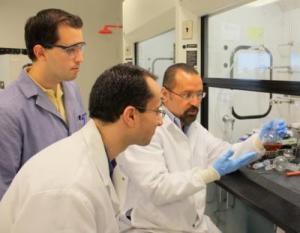Jan 19 2011
A complex sugar may someday become one of the most effective weapons to stop the spread of cholera, a disease that has claimed thousands of lives in Haiti since the devastating earthquake last year.
A technique developed by University of Central Florida scientists would allow relief workers to test water sources that could be contaminated with the cholera toxin. In the test, the sugar dextran is coated onto iron oxide nanoparticles and then added to a sample of the water. If the cholera toxin is present, the toxin will bind to the nanoparticles' dextran. This is because dextran looks similar to the cholera toxin receptor (GM1) found on cells' surface in the victim's gut.
 Dr. Perez works in his lab
Dr. Perez works in his lab
The technique likely would be less expensive than those currently available, and it would provide results more quickly, enabling workers to restrict access to contaminated sources and limit the spread of the disease.
"It's really quite amazing," said UCF assistant professor J. Manuel Perez, the lead researcher on the project. "It means we have a quicker diagnostic tool using a simple and relatively cheap sugar-nanoparticle combination."
Early studies also show that the technique could someday be used to treat someone infected with cholera, which is caused by poor sanitation and dirty water, and potentially other diseases, Perez said.
More studies are needed to prove the adaptability of the technique, but its impact could be huge. In countries with poor sanitation, outbreaks caused by drinking contaminated water often prove fatal. Deadly toxins also can result from bioterrorism or food contamination.
There are an estimated 3 million to 5 million cholera cases, and 100,000 to 120,000 deaths, worldwide each year, according to the World Health Organization. A cholera outbreak has killed more than 3,000 people in Haiti since the earthquake, and WHO warned earlier in January that the outbreak has not yet reached its peak.
Research findings appear online today in the journal Bioconjugate Chemistry. The National Institute of General Medical Sciences at the National Institutes of Health funded the research.
The findings may give the Federal Drug Administration, Centers for Disease Control and Prevention and several other agencies additional screening tools to combat toxins. The UCF-developed technique is faster than current detection methods, and it would likely be less expensive because these nanoparticles are cheap to make in large quantities. The detection instruments are compact in some cases the size of a desktop computer and a handheld calculator, and they could be turned into mobile devices that relief workers or food screeners could use in the field.
"As we have seen in the 2010 outbreak in Haiti, cholera remains a serious threat," said Janna Wehrle, Ph.D., of the National Institutes of Health, who oversees Dr. Perez's and other grants that focus on protein structures and interactions. "By developing a fast and sensitive test for cholera toxin that does not require sophisticated equipment or refrigeration, Drs. Perez and Teter have provided health care workers with a potentially valuable tool for use in areas struck by natural disasters or with inadequate infrastructure. The possibility that the novel chemistry discovered by these investigators might also be useful for treating cholera is especially exciting."
Studies that are under way may confirm early indications that dextran can be an effective drug for patients infected with cholera, added UCF Associate Professor Kenneth Teter, a co-author on the study. This could be especially beneficial in developing countries such as Haiti, as dextran is a relatively inexpensive compound to produce.
Additionally, both dextran and iron oxide are commonly used in other medical applications. Dextran is often used to prevent blood clots anticoagulant and in emergency treatments of hemorrhagic and traumatic shock. Iron oxide nanoparticles are used to treat anemia and as MRI contrast agents to achieve improved anatomical imaging.
Source: http://www.ucf.edu/